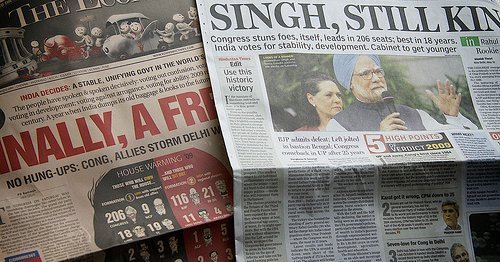Manmohan Singh is a renowned economist and this will certainly help the world’s largest democracy counter such economic slump.
The Congress Party adopted pro-poor policies in the previous government and this eventually paid off in the election. The pre-election manifesto of the Congress promised subsidised cereals for the poor, which eventually encouraged more peasants to vote for such party.
Along with Singh, there are other ex-members of the last government. Karmal Nath, a trade minister in the previous government, has become the minister of road transport and highways. The latter is seen as a prominent businessman and therefore this shows that the government’s intention is to speed up the implementation of infrastructure projects which had slowed under the previous government, Reuters reported.
When it comes to the negotiations at the World Trade Organisation (WTO), the U.S. trade representative Ron Kirk when on visit in Geneva revealed that Washington was committed to seeing the trade round launched in Doha in 2001 success and he did not want talks to start from scratch or throw away work already done.
U.S. president, Barack Obama, is very confident in completing a World Trade Organisation. In recent speeches Obama rightly identified trade as a key factor of pulling the world out of recession.
The communist party this time was unshackled from any other opponent as it seized to attract other allies so that to strengthen its position. Members of the DMK party and of the National Conference party were also included in the coalition of the Congress. This eventually made the party undefeated by the communists and other significant opponents. It is now ruling in comfortable majority with a coalition government.
Economic Slump
The Indian economy has slowed down to 6%-7% over the past year or so. Industrial production and exports have also declined and this eventually led to the loss of millions of jobs, especially in export-oriented industries such as textiles, garments and gems.
A substantial proportion of the 1.1billion population is extremely poor, even though it is considered to be the second-fastest growing economy in the world among large countries after China.
Singh claimed that “If we sustain the growth rates of the last five years, we can reduce poverty, create new employment, accelerate rural development and industrialisation and transform the lives of our people… We must grasp the nettle firmly and forge ahead.”
Successful Agricultural developments
From the early 1990s, a phase of ‘liberalisation’ and reduction of controls have been imposed by Mr Singh who became finance minister in an earlier Congress government.
The first Singh administration worked hard on improving lives of peasants with programmes such as that of the 100 day employment for families living in rural areas.
Conflicting Neighbours
Mr Shing has to deal cautiously with India’s neighbours Pakistan and Afghanistan where Islamic Fundamentalists are threatening to overrun both countries.
In Nepal, there is instability in governance after the Maoists withdrew from government. Burma is least stable of all. Of all the Indian neighbours, Bangladesh is the most politically stable after the pro-India Awami League was elected in December.


Follow the comments: |
|
